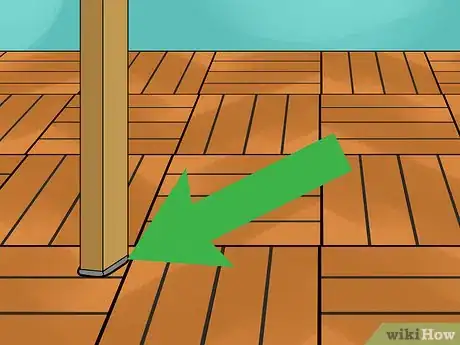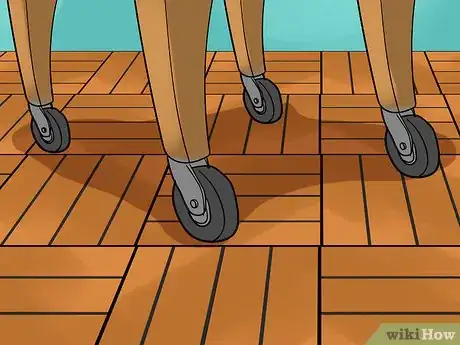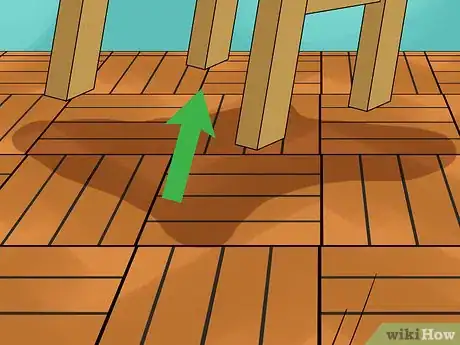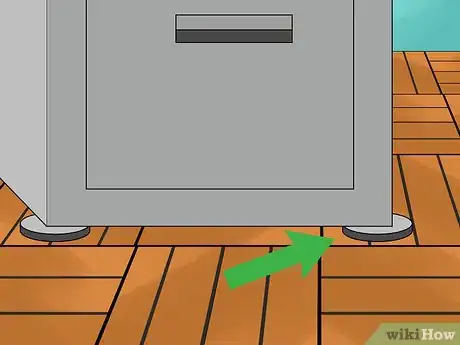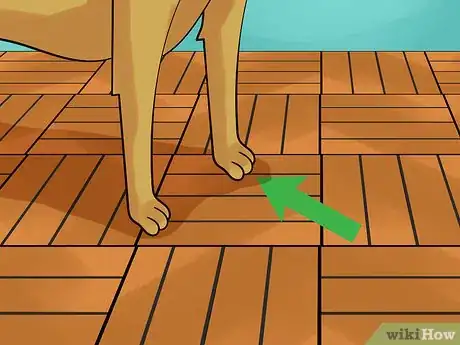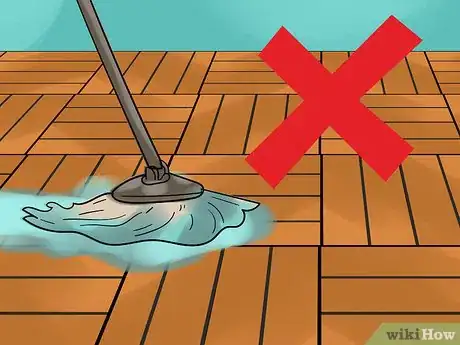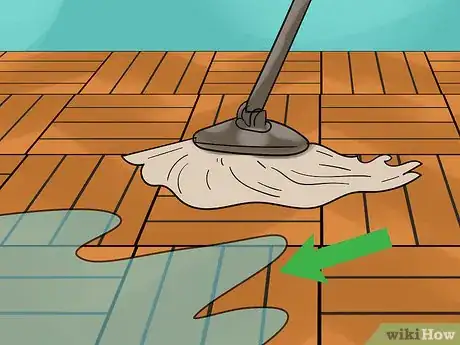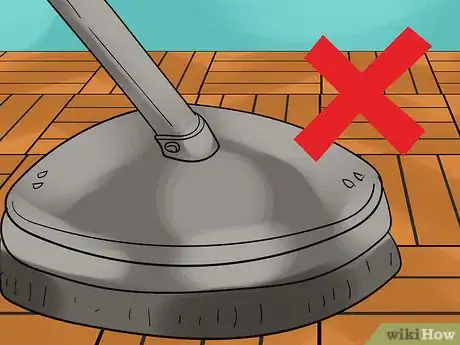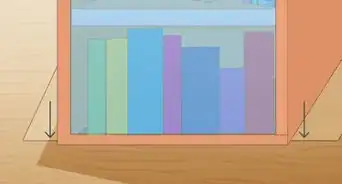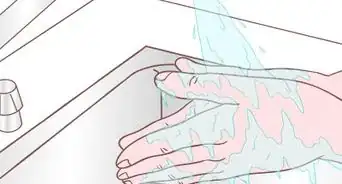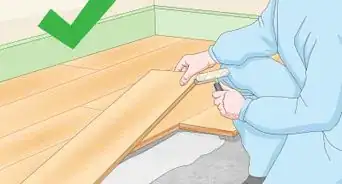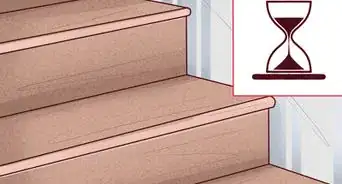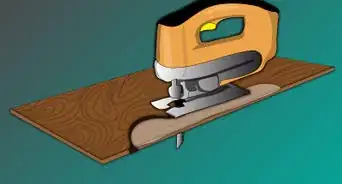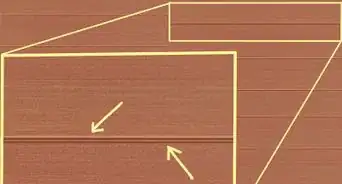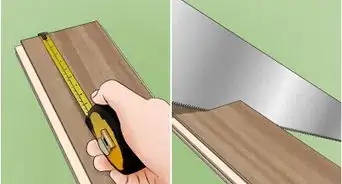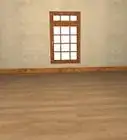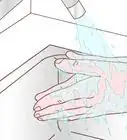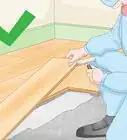This article was co-authored by Patrick Coye. Patrick Coye is the owner and operator of Patrick’s Painting & Home Improvement in Alexandria, Virginia. With over 15 years of experience in residential construction, Patrick specializes in painting, wallpaper removal/installation, drywall, staining decks and fences, and kitchen cabinetry painting. To date, Patrick and his team have painted over 2,000 houses and stained over 800 decks. Patrick's Company won a "Top Job" award from the American Painting contractor magazine in 2020.
wikiHow marks an article as reader-approved once it receives enough positive feedback. In this case, 97% of readers who voted found the article helpful, earning it our reader-approved status.
This article has been viewed 201,906 times.
Laminate flooring can be susceptible to scratches, dents, scuff marks, and other types of damage. Flooring is especially susceptible in areas with heavy foot traffic, or when you move furniture, such as chairs, across the flooring on a regular basis. In some cases, humid weather or the toenails of your pets can also damage laminate flooring. You can protect your laminate flooring with items like rugs and pads, with proper cleaning, and with other modifications.
Steps
Protecting with Pads and Rugs
-
1Attach protector pads to the bottom of furniture. Furniture tends to move slightly across flooring with daily use. Pads will help prevent the bottom of your furniture or other sharp parts from scraping or scratching against your laminate flooring. You can purchase pads made out of several different types of materials, like felt, plastic, carpet, and cane. You can purchase protector pads from most home improvement and flooring stores.[1]
- Purchase protector pads, or discs, with adhesive on one side that you can stick to the bottom of your furniture.
- Periodically examine the felt protector pads you attached. The pads may need to be replaced when the felt becomes compressed due to regular wear of the furniture.
-
2Put carpets or rugs on your laminate flooring. “Lanes” can often form in areas of laminate flooring that are often used. Rugs or carpets can be placed in areas with heavy foot traffic to avoid this problem. You can place rugs under furniture to prevent scratches and scrapes from marring the laminate flooring, too. Rugs can also be placed in areas that are likely to come into contact with water, like under the kitchen sink.
- Place rubber or non-slip pads beneath your rugs in heavy foot traffic areas to prevent them from sliding around.
Advertisement -
3Place entry welcome mats at doorways. Dirt, pebbles, and sand from shoes can easily scratch laminate flooring. Putting mats at your doorways can prevent this from happening. This will allow you, your family, or other visitors to wipe their feet before entering your home. You can also place mat at other areas in the home that are at risk of being scratched by debris .[2]
- You can enforce a rule that bans people from wearing shoes inside your home, which may help eliminate any debris that is tracked onto the laminate flooring from shoes.
-
4Replace plastic casters with rubber wheels. Chairs are probably the most often moved pieces of furniture in the home, especially those at kitchen tables and desks. Take the plastic casters off of the chairs and replace them with rubber wheels. This will prevent scratching and damage to the floor.[3]
- Make sure to buy soft rubber wheels. You can buy this online from websites like castercity.com, and from many home improvement and office stores.[4]
Treating the Floor Gently
-
1Lift furniture instead of dragging it. Do not drag or push furniture across the floor when you move it around. Instead, lift the furniture if possible. Lifting your furniture will prevent the scratches and scuff-marks that can be caused by dragging your furniture. If the furniture can’t be lifted, it is also an option to place slide it across the floor with something underneath it.
- Do not do any lifting on your own if you feel that the furniture is too heavy. Ask a friend or family member for help.
-
2Slide heavy furniture across the floor. If you have difficulty moving large or heavy pieces of furniture, place plastic discs with padding on one side (also known as furniture sliders or moving discs) underneath your furniture. These discs will allow large and heavy furniture to glide across the laminate flooring without causing damage. Soft, thick towels or heavy blankets can also be placed underneath heavy or large furniture as an alternative to plastic discs.
- Ask friends or family to help you with lifting furniture that is too large or heavy for you to move by yourself.
-
3Keep the humidity levels in your home between 35 and 65 percent. This will prevent your laminate flooring from warping due to the expansion or contraction of the laminate flooring materials. Use a humidistat to measure the humidity levels in your home. You may already have a humidistat built into your thermostat or humidifier, or you can purchase one from a retail store that specializes in home repair.
- Use a humidifier during dry conditions to prevent your laminate flooring from shrinking, and use an air conditioner or dehumidifier in wet conditions to prevent your flooring from expanding.
-
4Keep the nails of your pets trimmed. Long nails on your pet can cause extra damage to the floor. Make sure to keep your pet’s nails trimmed, but do not cut them so low that it injures the animal. Take your pet to a groomer, or trim your pet's nails using nail clippers designed for use on pets.
- You should also check the pet’s paws when they come from outside to inside and remove any dirt and/or gravel.
Cleaning the Laminate Floor
-
1Avoid wet mopping. Wet mopping will cause extra water to seep into the floor, which will damage it over time. Mopping with water should also be avoided because soap and detergent based cleaners used with wet mopping damages laminate. Instead, purchase a spray on cleaner specially made for laminate floors and wipe the floors with a cloth, or use a dry mop.
- Manufacturers of laminate flooring will often put out their own brands of cleaning products. It is best to use what is specifically made for your type of flooring.[5]
- Generic brands are sold at supermarkets and flooring stores. Generic brands are typically okay to use, though you should test it on a small spot of your floor first.
-
2Clean spills from the laminate flooring as soon as they occur. This will prevent liquids from entering any cracks or joints in your flooring, which can eventually weaken your laminate flooring or cause it to warp. Use a soft cloth or mop to clean up spills instead of an abrasive sponge or other material that can scratch your flooring. Clean it up with the cloth alone, or with a cleaning product recommended by the manufacturer of your flooring if possible.
- If you are required to use a cleaning product other than water to clean up spills and can’t find a product made by your manufacturer, use a commercial window cleaner that does not contain ammonia. Ammonia contains properties that may strip away the protective sealant from the laminate flooring.
-
3Don’t use a vacuum with rotary brush heads. Do not use a vacuum with a rotary brush or beater bar head on laminate floors. These types of heads can damage the flooring. Instead, use a felt or brush type vacuum. Before vacuuming, check to make sure the wheels are clean and haven’t collected any dirt or grit.
- Vacuum and sweep daily to minimize the amount of dirt and grit on the floors.
-
4Make repairs quickly. You can repair minor damage on your own by purchasing a repair kit made specifically for laminate floors. Kits will typically be made up of silicon filler and wax sticks. More extensive damage may require a replacement of tiles or planks. It is best to seek a professional for extensive damage that will require replacement.
- Companies like Precision, Liberon, and Picobello offer laminate repair kits.
- You can buy repair kits at home improvement stores and online from websites such as Amazon.
Community Q&A
-
QuestionIs there a product that would make laminate flooring water resistant or waterproof? If so, what's best?
 Community AnswerThere are products on the market that are waterproof. One is manufactured under the name Paradigm. It is designed to hold up to overflowing in the kitchen, bath and laundry room.
Community AnswerThere are products on the market that are waterproof. One is manufactured under the name Paradigm. It is designed to hold up to overflowing in the kitchen, bath and laundry room. -
QuestionCan I wax laminate flooring?
 Community AnswerWaxing is typically not needed for laminate flooring because the floor is already covered with a protectant--the laminate.
Community AnswerWaxing is typically not needed for laminate flooring because the floor is already covered with a protectant--the laminate. -
QuestionIs it okay to use a Shark steam pocket mop on my laminate flooring?
 Community AnswerAbsolutely not! It will push steam (which is water) into the flooring and cause warping.
Community AnswerAbsolutely not! It will push steam (which is water) into the flooring and cause warping.
Warnings
Things You'll Need
- Adhesive felt protector pads
- Nail clippers for pets
- Cleaner without a soap or detergent base
- Plastic furniture sliders
- Soft cloth or mop
- Humidistat
- Entry mat
References
- ↑ http://www.diycentral.com/how-to-protect-laminate-flooring-291/
- ↑ https://na.pergo.com/how-to/floor-care-maintenance
- ↑ https://na.pergo.com/how-to/floor-care-maintenance
- ↑ http://www.castercity.com/casters-for-wood-floors.htm
- ↑ Patrick Coye. Painting Specialist. Expert Interview. 22 July 2020.
- ↑ http://www.diycentral.com/how-to-protect-laminate-flooring-291/
- ↑ https://na.pergo.com/how-to/floor-care-maintenance
- ↑ https://na.pergo.com/how-to/floor-care-maintenance
About This Article
To protect laminate flooring, attach felt or plastic protector pads to the bottom of your furniture legs so they don’t scratch the floor. If you have furniture with casters, replace the plastic wheels with soft rubber ones, which are less likely to damage the floor when you move the piece. When you wash the floor, avoid wet mopping, since the water can seep underneath. Instead, use a spay cleaner with a dry mop. Additionally, clean up any spills as quickly as you can to prevent liquid from getting into cracks or joints in the laminate. For advice on how to repair scratches or cracks in your laminate flooring, read on.
